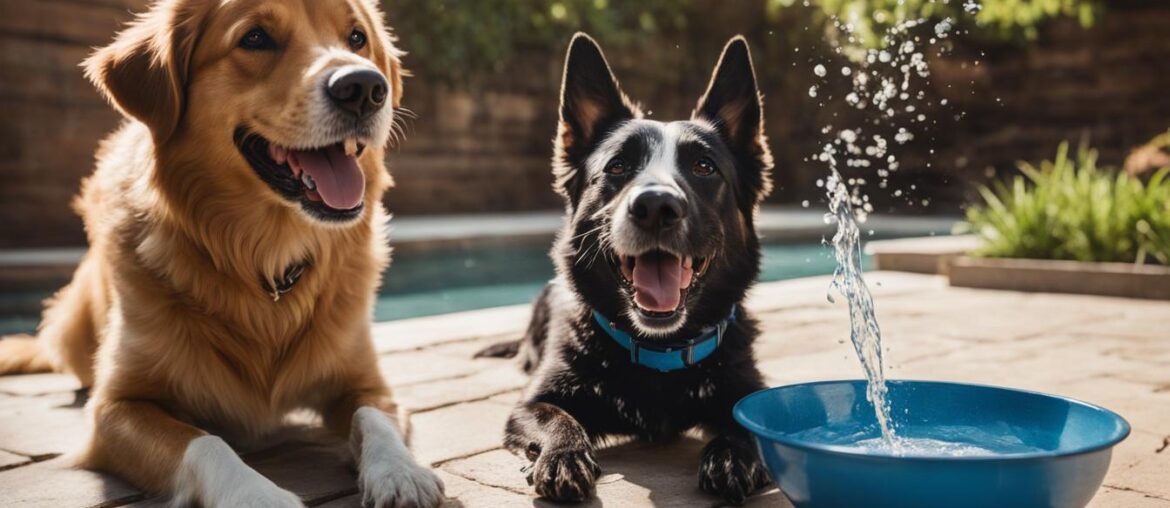Every dog owner knows the importance of keeping their furry friend hydrated. However, some dogs can be stubborn when it comes to drinking water. Dehydration can lead to serious health problems, so it’s crucial to ensure that your dog is drinking enough water. In this article, I will provide you with easy and effective steps to encourage your dog to drink water and improve their hydration.
Key Takeaways:
- Training your dog to drink water is essential for their overall health and well-being.
- Dehydration can lead to serious health problems, so it’s important to encourage proper hydration in your dog.
- Offer your dog fresh and clean water at all times to promote increased water intake.
- Try different techniques such as adding flavor to their water or incorporating wet food to entice your dog to drink more.
- If your dog consistently refuses to drink water, consult a veterinarian to rule out any underlying health issues.
Why is Water Intake Important for Dogs?
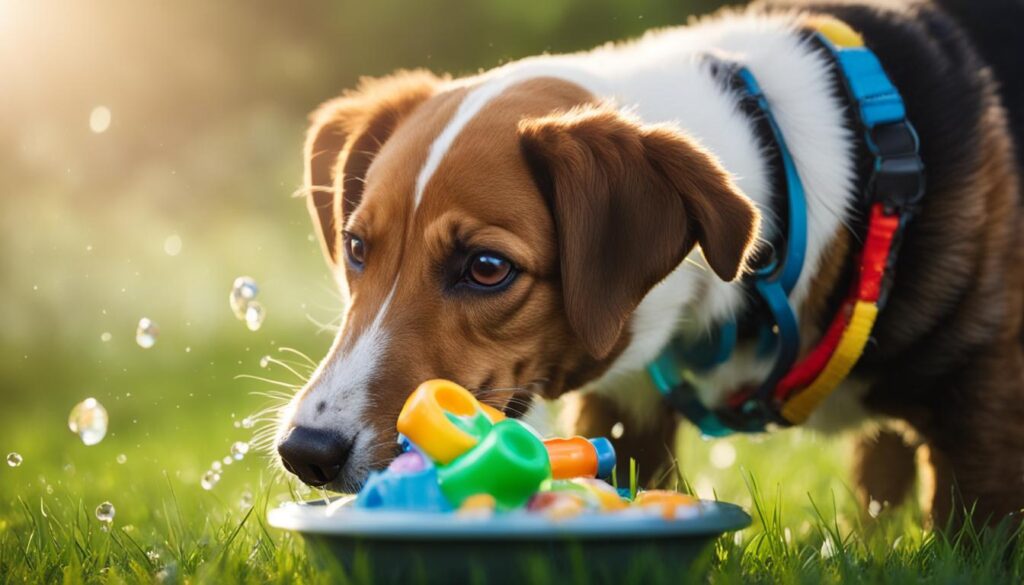
Water plays a vital role in maintaining the overall health and well-being of dogs. Just like humans, dogs rely on water to function properly and stay hydrated. Adequate water intake is crucial for several reasons:
- Regulating body temperature: Water helps dogs regulate their body temperature, especially during hot weather or physical activity. It enables them to cool down through panting and sweating from their paw pads.
- Aiding digestion: Water is essential for breaking down food and facilitating digestion. It helps dissolve nutrients and transport them throughout the body, ensuring proper nutrient absorption.
- Lubricating joints: Water serves as a natural lubricant for dogs’ joints, reducing friction and supporting smooth movements. Sufficient hydration can help prevent joint problems and improve mobility.
- Flushing out toxins: Drinking water allows dogs to flush out toxins and waste products from their bodies. It helps maintain optimal kidney function and prevents the accumulation of harmful substances.
- Supporting organ function: Water is essential for the proper functioning of organs such as the liver, kidneys, and bladder. It enables these organs to carry out their functions effectively.
“Proper hydration is crucial to prevent dehydration-related complications and maintain your dog’s overall health and well-being.”
Without sufficient water intake, dogs can become dehydrated, which can lead to serious health issues. Dehydration in dogs can result in urinary tract infections, kidney problems, and even organ failure. It is important to promote and monitor your dog’s water intake to ensure they stay hydrated and avoid these consequences.
| Consequences of Insufficient Water Intake in Dogs | Signs of Dehydration in Dogs |
|---|---|
|
|
Signs of Dehydration in Dogs
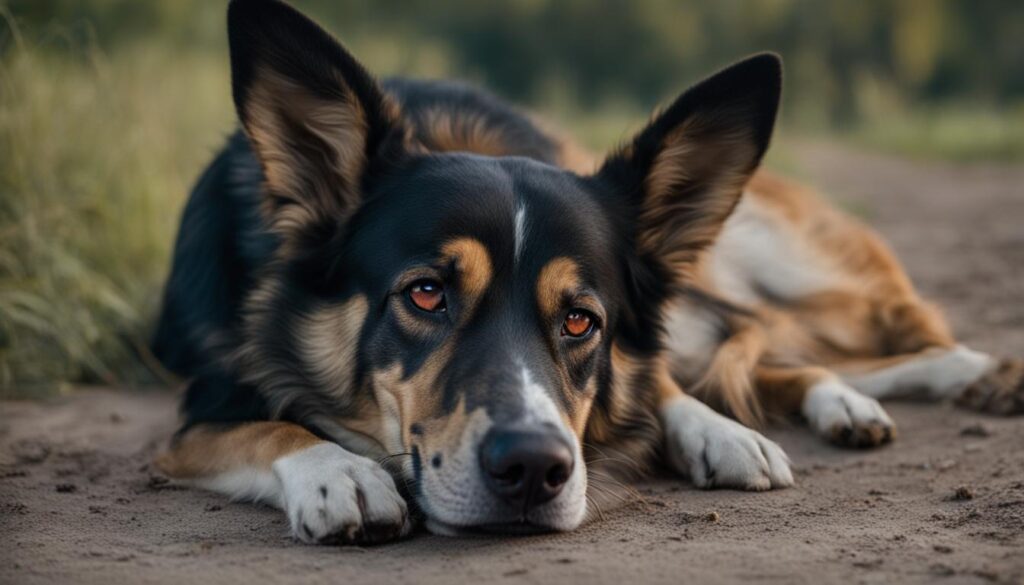
Recognizing the signs of dehydration in dogs is crucial in order to intervene promptly and prevent further health issues. Dehydration can have serious consequences for your furry friend, so it’s essential to be aware of the symptoms and take immediate action. Here are some common signs of dehydration to watch out for:
- Dry gums and tongue: One of the most noticeable signs of dehydration in dogs is dry gums and a sticky or tacky tongue. A hydrated dog will typically have moist gums and a wet tongue.
- Lethargy: Dehydration can cause your dog to become lethargic and lack energy. If your dog seems unusually tired or sluggish, it could be a sign of dehydration.
- Loss of appetite: A decrease in appetite can be an indicator that your dog is not getting enough fluids. If they show little interest in their food or refuse to eat altogether, it may be a sign of dehydration.
- Sunken eyes: Dehydration can cause a dog’s eyes to appear sunken or hollow. If you notice a significant change in the appearance of your dog’s eyes, it’s important to address their hydration levels.
- Decreased skin elasticity: The skin of a hydrated dog will spring back when lightly pulled. However, if your dog is dehydrated, the skin may be slow to return to its original position after being lifted.
It’s crucial to pay attention to these signs and take immediate action to encourage your dog to drink water. Dehydration can lead to serious health complications, so ensuring your dog stays hydrated is essential for their overall well-being.
| Signs of Dehydration | Description |
|---|---|
| Dry gums and tongue | One of the most noticeable signs of dehydration in dogs. Keep an eye out for dry gums and a sticky or tacky tongue. |
| Lethargy | Dehydration can cause your dog to become lethargic and lack energy. If your dog seems unusually tired or sluggish, it could be a sign of dehydration. |
| Loss of appetite | A decrease in appetite can be an indicator that your dog is not getting enough fluids. If they show little interest in their food or refuse to eat altogether, it may be a sign of dehydration. |
| Sunken eyes | Dehydration can cause a dog’s eyes to appear sunken or hollow. If you notice a significant change in the appearance of your dog’s eyes, it’s important to address their hydration levels. |
| Decreased skin elasticity | The skin of a hydrated dog will spring back when lightly pulled. However, if your dog is dehydrated, the skin may be slow to return to its original position after being lifted. |
Tips for Encouraging Your Dog to Drink Water
If your dog is not drinking enough water, there are several tips and techniques you can try to encourage them to drink more.
- Offer clean and fresh water at all times: Ensure that your dog always has access to a clean and fresh bowl of water. This will make it more inviting for them to take a sip.
- Add ice cubes to their water bowl: Some dogs prefer cold water, so adding a few ice cubes to their bowl can make it more appealing and refreshing.
- Incorporate water into their diet: You can increase your dog’s water intake by adding wet food to their diet. Wet food has a higher moisture content, providing hydration along with their meal. You can also mix water with their dry food to make it more enticing.
- Try a water fountain or cupped hand: Some dogs prefer running water, so using a water fountain can catch their attention and encourage them to drink. Alternatively, offering water from a cupped hand can simulate the sensation of water flowing and prompt them to drink more.
Remember, proper hydration is essential for your dog’s overall health and well-being. By employing these tips, you can help ensure that your furry friend stays hydrated and healthy.
Making Water More Appealing to Your Dog
If your dog is not interested in drinking water, there are some tricks you can try to make it more appealing to them.
- Adding Flavor: A splash of flavor can entice your dog to drink water. Try adding low-sodium broth or bone broth to their water bowl. The savory taste can make the water more enticing and encourage them to drink.
- Ice Cubes: Some dogs enjoy the novelty and the cooler temperature of ice cubes. Adding a few ice cubes to their water bowl can make it more interesting and refreshing for them.
- Incorporating Wet Food: Wet food is a great source of hydration for dogs as it contains a higher moisture content. Consider incorporating wet food into their diet to increase their water intake. You can mix it with their dry food or serve it separately.
By trying these tricks, you can make water more appealing to your dog and encourage them to drink more. Remember to monitor their water intake and provide them with clean and fresh water at all times. Adequate hydration is essential for your dog’s overall health and well-being.
| Trick | Description |
|---|---|
| Adding Flavor | A splash of low-sodium broth or bone broth can entice your dog to drink water. |
| Ice Cubes | Some dogs enjoy the novelty and coolness of ice cubes in their water bowl. |
| Incorporating Wet Food | Wet food contains a higher moisture content and can increase your dog’s water intake. |
Overcoming Water Intake Challenges
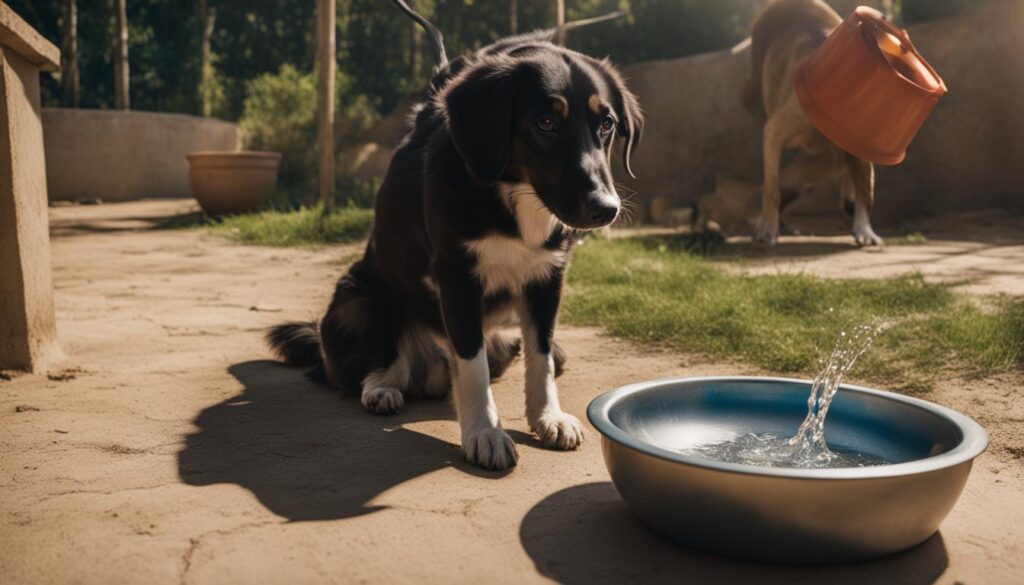
If your dog consistently refuses to drink water despite your efforts, it may be necessary to seek veterinary advice. There could be underlying health issues causing their decreased water intake, such as kidney problems or dental pain. Your vet can provide further guidance on addressing these issues and ensuring your dog receives adequate hydration.
Addressing water intake issues in dogs can be a frustrating and concerning experience for dog owners. When your furry companion doesn’t drink enough water, it can lead to dehydration and potential health problems. While there can be several reasons for a dog not drinking water, such as behavioral factors, environmental changes, or underlying health conditions, seeking veterinary advice is crucial to identify the root cause and take appropriate measures.
Veterinarians are trained professionals who can assess your dog’s overall health, conduct necessary tests, and provide expert advice on addressing water intake challenges. They may recommend specific tests to rule out medical conditions or prescribe medications if needed. Veterinary advice can help you tailor a plan to encourage your dog to drink more water and ensure their proper hydration.
When visiting the veterinarian, it’s essential to provide detailed information about your dog’s behavior, eating habits, any recent changes in their routine or environment, and any other symptoms they may be experiencing. This information can assist the vet in making an accurate diagnosis and providing appropriate treatment options.
Seeking veterinary advice for your dog’s water intake is an important step in ensuring their overall health and well-being. Consulting with a professional can help address any underlying health issues and provide guidance on promoting proper hydration in your dog.
Importance of Regular Water Intake for Dog’s Health
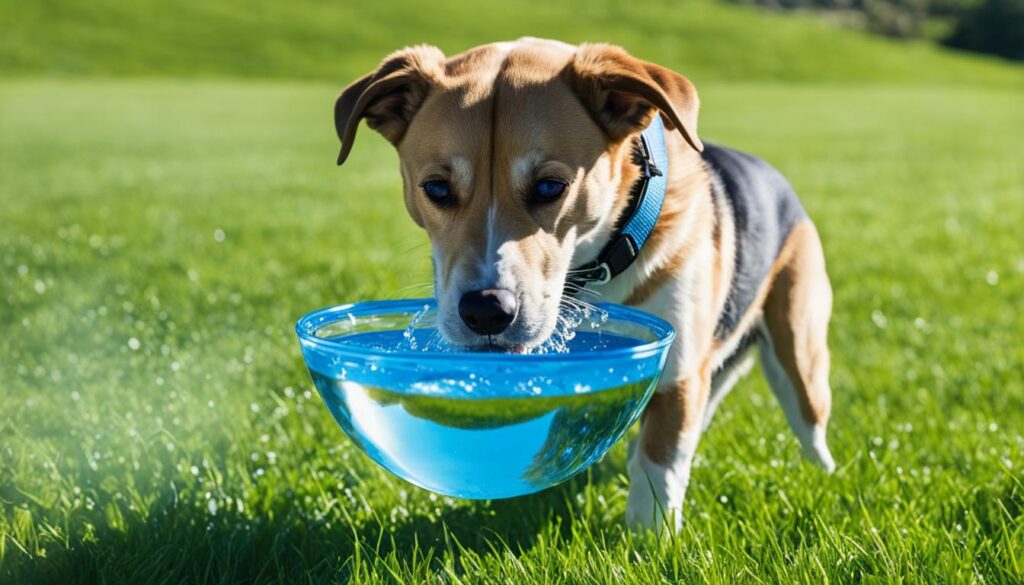
Regular water intake is vital for maintaining your dog’s overall health and well-being. Hydration plays a crucial role in preventing a variety of health problems and promoting their overall vitality. By ensuring that your dog drinks enough water, you are taking a proactive step in safeguarding their health and well-being.
Benefits of Proper Hydration in Dogs
Proper hydration offers numerous benefits for your dog’s health. It helps prevent common issues such as urinary tract infections, kidney problems, and constipation by keeping their urinary system and digestive tract functioning optimally. Adequate water intake also supports their immune system, assisting in disease prevention and promoting faster recovery.
In addition, water plays a vital role in maintaining the health of your dog’s skin and coat. Sufficient hydration helps prevent dry skin, itchiness, and dandruff, resulting in a shiny and lustrous coat.
Preventing Health Problems with Water Intake
Regular and adequate water intake in dogs can help prevent a wide range of health problems. Dehydration, if left untreated, can lead to severe complications, including organ failure, electrolyte imbalances, and even death. By ensuring that your dog consistently drinks enough water, you can minimize the risk of these potentially life-threatening conditions.
Proper hydration also aids in the prevention of urinary tract problems, such as bladder stones and infections. Sufficient water intake helps to flush out toxins and bacteria from the urinary system, reducing the risk of these issues.
Water as a Preventive Measure for Dog’s Health
Water serves as a preventive measure for various health concerns in dogs. By encouraging your dog to drink water on a regular basis, you can help prevent the development of urinary tract infections, kidney problems, and digestive issues.
Additionally, water plays a crucial role in managing weight and preventing obesity in dogs. Proper hydration can help your dog feel fuller and minimize overeating. It can also assist in maintaining healthy digestion and preventing constipation.
Remember, prevention is key when it comes to your dog’s health. By prioritizing regular water intake, you are effectively taking a proactive approach to their overall well-being.
Monitoring Your Dog’s Water Intake

Monitoring your dog’s water intake is a crucial aspect of ensuring their overall health and well-being. By tracking their water consumption, you can gain valuable insights into their hydration levels and address any potential issues promptly.
One effective method of monitoring your dog’s water intake is by measuring the amount of water you provide and observing how much is left at the end of the day. This simple technique allows you to gauge their daily water intake and identify any significant changes or irregularities.
By regularly assessing your dog’s water intake, you can ensure they are receiving the necessary hydration to support their bodily functions and prevent dehydration. Adequate water intake helps regulate their body temperature, aids digestion, and promotes healthy organ function.
Additionally, monitoring your dog’s water consumption can be particularly beneficial if they have specific health conditions or are on medication that may affect their thirst levels. By closely observing their water intake, you can work with your veterinarian to adjust their medication or develop strategies to promote proper hydration.
Remember, every dog is unique, and their water intake requirements may vary based on factors such as age, size, activity level, and environmental conditions. Monitoring their water consumption allows you to tailor their hydration needs accordingly and provide them with the optimal level of hydration for their well-being.
Keep in mind that if you notice any significant changes in your dog’s water intake, such as a sudden increase or decrease, it is recommended to consult your veterinarian. These changes may indicate underlying health issues that require further evaluation and treatment.
| Benefits of Monitoring Your Dog’s Water Intake: |
|---|
| Ensures proper hydration for optimal health |
| Identifies changes in water intake, which may indicate health issues |
| Allows adjustments for dogs with specific health conditions or on medication |
| Promotes proactive management of your dog’s hydration needs |
Monitoring your dog’s water intake is a proactive approach to promoting their overall health and well-being. By staying vigilant and responsive to their hydration needs, you can ensure that your furry friend remains happy, healthy, and properly hydrated.
Ensuring Access to Fresh Water
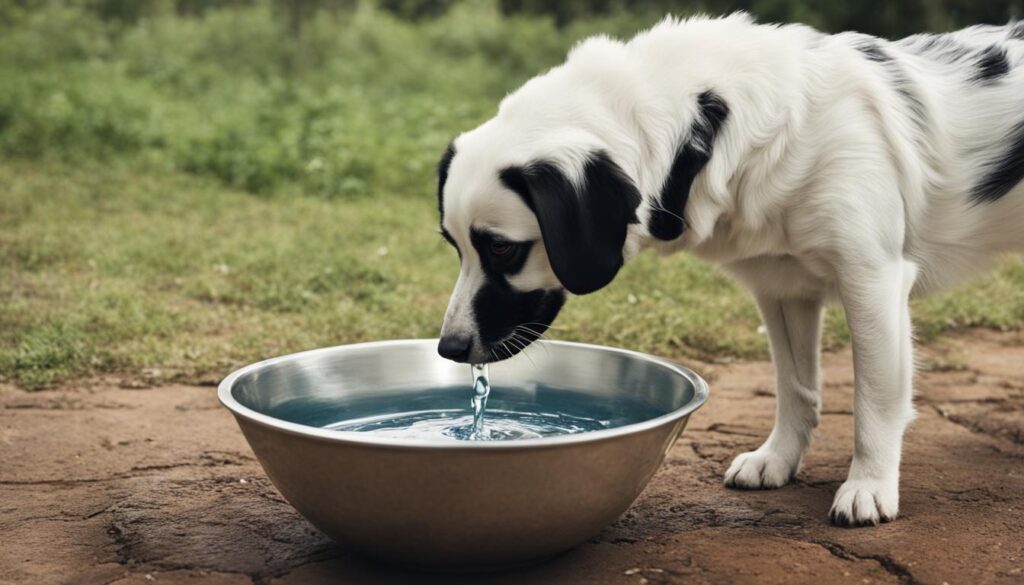
To encourage your dog to drink water, it’s crucial to provide them with access to clean and fresh water at all times. Changing their water regularly helps prevent any bacterial growth or contamination, ensuring that the water remains safe and appealing to your dog.
Clean water is essential for your dog’s health and well-being. By regularly cleaning their water bowl, you can maintain good hygiene and prevent the buildup of dirt, debris, or bacteria that may deter your dog from drinking.
Here are some key steps to ensure access to fresh water for your dog:
- Provide a clean and fresh water bowl for your dog every day.
- Change the water regularly, at least once or twice a day, to keep it fresh and pure.
- Wash the water bowl with soap and water daily to remove any residue and ensure cleanliness.
- Inspect the water bowl for cracks, scratches, or mold and replace it if necessary.
Remember, dogs are sensitive to odors, tastes, and water temperature. By ensuring access to fresh water and maintaining proper water bowl hygiene, you can promote your dog’s water intake and overall hydration.
| Tip | Description |
|---|---|
| Provide clean water | Ensure the water bowl is free from dirt, debris, and bacteria. |
| Change water regularly | Replace the water at least once or twice a day to keep it fresh. |
| Wash the water bowl | Clean the water bowl with soap and water daily to remove residue and maintain hygiene. |
| Inspect the water bowl | Check for cracks, scratches, and mold in the water bowl, replacing it if needed. |
Wrapping Up
Proper hydration plays a crucial role in maintaining the health and well-being of your dog. By implementing the tips and techniques mentioned in this article, you can encourage your furry friend to drink more water and ensure their optimal hydration levels. Remember to monitor their water intake regularly, providing them with fresh and clean water at all times. Additionally, consider incorporating other sources of hydration, such as wet food or flavored water, to make drinking water more enticing for your dog. Prioritizing your dog’s water intake is a proactive step in preventing dehydration-related health issues and promoting their overall health and happiness.
So, whether it’s offering a cool bowl of water, adding flavor to make it more appealing, or seeking veterinary advice for persistent water intake challenges, maintaining proper hydration is essential for your dog’s well-being. By recognizing the signs of dehydration and taking the necessary steps to encourage your dog to drink water, you are providing them with the best chance for a healthy and hydrated life. Remember, your furry friend relies on you to ensure they receive adequate hydration, so make it a priority to keep their water bowl full and their thirst quenched.
Make water intake a part of your daily routine with your dog, and you’ll be rewarded with their improved health and happiness. By prioritizing your dog’s hydration, you are taking an important step in promoting their overall well-being and ensuring a long and vibrant life together. So, remember to offer fresh and clean water daily, monitor their intake, and utilize the tips mentioned here to keep your dog well-hydrated. Your furry friend will thank you with their wagging tail and a healthier, happier life.
FAQ
How can I encourage my dog to drink more water?
There are several tips you can try to encourage your dog to drink more water. Ensure you offer them a clean and fresh bowl of water at all times. Some dogs prefer cold water, so adding ice cubes to their water bowl can make it more appealing. You can also try incorporating water into their diet by adding wet food or mixing water with their dry food. Additionally, some dogs prefer running water, so using a water fountain or offering water from a cupped hand may entice them to drink more.
What are the signs of dehydration in dogs?
Signs of dehydration in dogs include dry gums and tongue, lethargy, loss of appetite, sunken eyes, and decreased skin elasticity. It’s essential to pay attention to these signs and take immediate action to encourage your dog to drink water.
How can I make water more appealing to my dog?
To make water more appealing to your dog, you can try adding a splash of flavor to their water, such as low-sodium broth or bone broth. You can also try adding ice cubes to their water bowl, as some dogs enjoy the novelty and cooler temperature. Incorporating wet food into their diet can also increase their water intake, as wet food contains a higher moisture content.
What should I do if my dog consistently refuses to drink water?
If your dog consistently refuses to drink water despite your efforts, it may be necessary to seek veterinary advice. There could be underlying health issues causing their decreased water intake, such as kidney problems or dental pain. Your vet can provide further guidance on addressing these issues and ensuring your dog receives adequate hydration.
Why is water intake important for dogs?
Water intake is essential for dogs as it helps regulate their body temperature, aids digestion, lubricates their joints, flushes out toxins, and keeps their organs functioning optimally. Without sufficient water intake, dogs can become dehydrated, leading to various health issues such as urinary tract infections, kidney problems, and even organ failure.
How can I monitor my dog’s water intake?
To monitor your dog’s water intake, you can measure the amount of water you provide and note how much is left at the end of the day. This will give you an idea of their daily water intake and help you identify any changes or potential issues.
Why is it important to ensure access to fresh water for your dog?
It is crucial to provide your dog with access to clean and fresh water at all times. Changing their water regularly prevents bacterial growth or contamination. Regularly cleaning their water bowl maintains good hygiene and ensures that the water remains fresh and appealing to your dog.
What are the health benefits of regular water intake for dogs?
Regular water intake helps prevent health problems such as urinary tract infections, kidney issues, and constipation in dogs. It also supports their immune system, aids in digestion, and promotes healthy skin and coat.
How can I overcome water intake challenges in my dog?
If your dog is facing challenges with water intake, such as consistently refusing to drink, it is important to identify the underlying cause. Seeking veterinary advice can help address any health issues and provide guidance on promoting water intake in your dog.
What are some tips for encouraging my dog to drink water?
To encourage your dog to drink water, offer them fresh and clean water at all times. Experiment with different water temperatures, incorporate flavoring or wet food, and consider using a water fountain or cupped hand to entice them. Ensuring a pleasant and appealing water-drinking experience can help increase their water intake.


